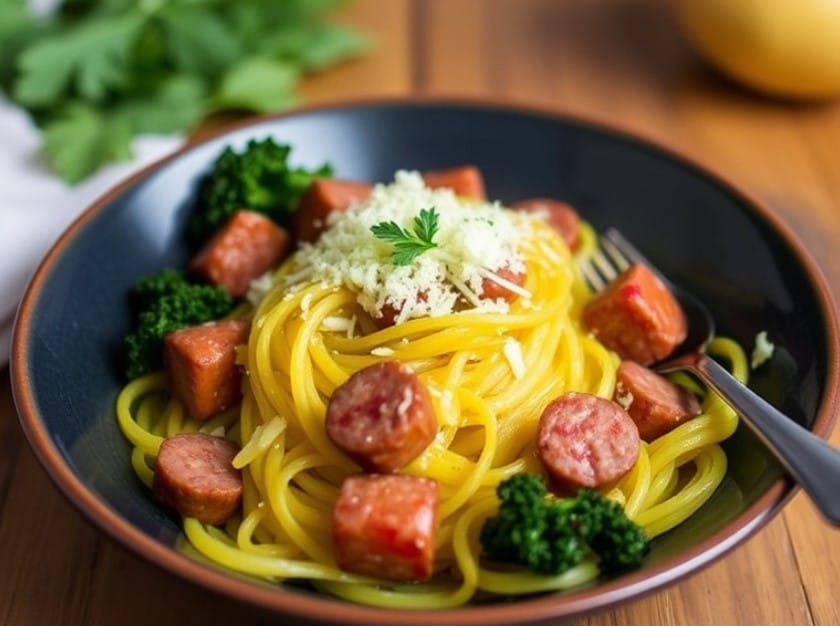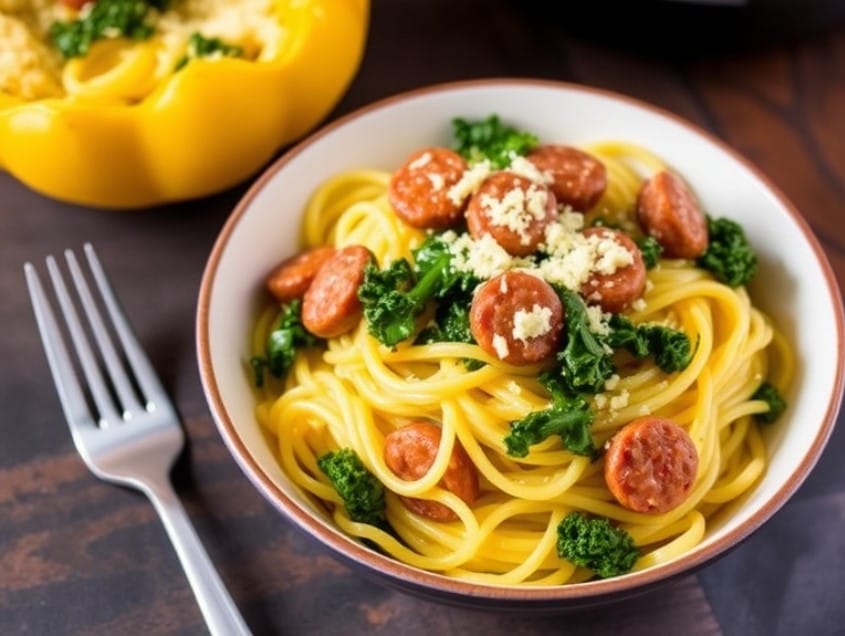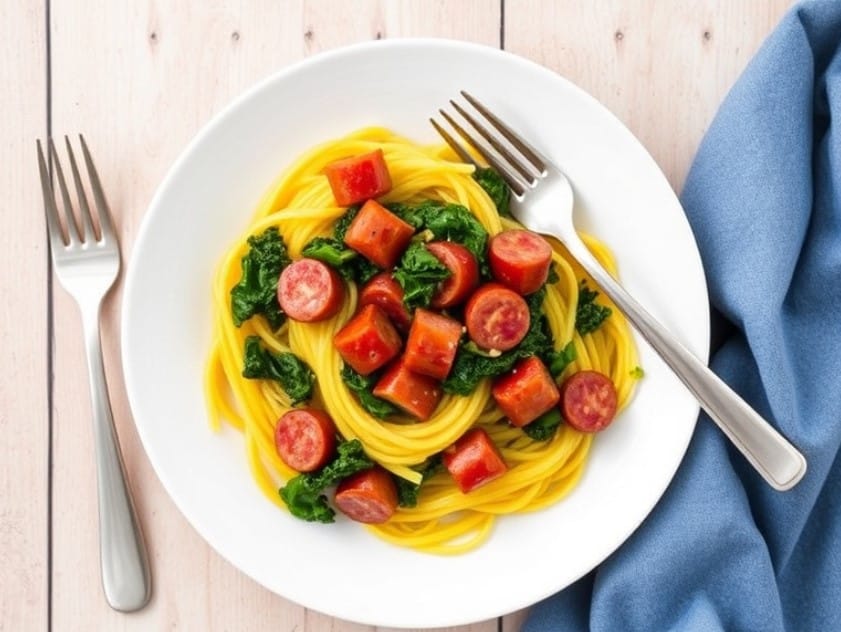The Best Spaghetti Squash with Sausage and Kale
Spaghetti squash is a nutritious, low-carb substitute for pasta, perfect for health-conscious eaters. When combined with savory sausage and the nutritious leafy green, kale, this dish becomes a hearty, balanced meal. Spaghetti Squash with Sausage and Kale is perfect for those looking for a gluten-free, low-carb, or keto-friendly meal without compromising on taste. In this comprehensive recipe guide, we will explore everything you need to know about preparing this delicious and healthy dish, including tips, ingredient substitutions, and how to ensure optimal flavors.

Table of Contents:
- Nutritional Benefits of Spaghetti Squash with Sausage and Kale
- Ingredients Needed
- Step-by-Step Cooking Instructions
- Variations and Ingredient Substitutions
- Storage and Reheating Tips
- Frequently Asked Questions
- Conclusion
Nutritional Benefits of Spaghetti Squash with Sausage and Kale
Before diving into the recipe, let’s explore the health benefits of the main ingredients: spaghetti squash, sausage, and kale.
Spaghetti Squash
Spaghetti squash is a low-calorie vegetable, rich in vitamins, fiber, and antioxidants. One cup of cooked spaghetti squash contains:
- Calories: Approximately 42
- Carbohydrates: 10 grams (lower than traditional pasta)
- Dietary Fiber: 2.2 grams
- Vitamin C: 20% of the daily value (DV)
- Vitamin B6: 8% of the DV
- Magnesium: 6% of the DV
Spaghetti squash is a perfect substitute for those on a low-carb diet, offering a similar texture to pasta without the high carb content.
Sausage
Sausage, especially when using high-quality varieties like chicken or turkey sausage, adds a rich source of protein to the dish. Sausages provide key vitamins and minerals, including:
- Protein: Essential for muscle repair and growth
- Iron: Helps inside the transportation of oxygen for the duration of the frame
- Vitamin B12: Supports red blood cell formation and nerve function
Opting for lean sausages or homemade versions allows you to control the fat content, making the meal healthier.
Kale
Kale is one of the maximum nutrient-dense leafy greens to be had. It is loaded with vitamins, minerals, and antioxidants, making it a true superfood. Nutritional highlights of kale include:
- Vitamin K: Over 500% of the DV in a single cup, supporting bone health and blood clotting
- Vitamin A: Essential for eye health and immune feature
- Calcium: Strengthens bones and teeth
- Antioxidants: help combat oxidative stress and inflammation in the body.
By combining spaghetti squash, sausage, and kale, you create a meal that is not only tasty but also packed with nutrients that promote overall health.
Ingredients Needed
To prepare Spaghetti Squash with Sausage and Kale, you’ll need the following ingredients:
Optional Garnishes:
- Fresh parsley, finely chopped
- A drizzle of olive oil or lemon juice
- Add crunch by topping the dish with toasted pine nuts or crushed walnuts.
Related Recipes
- Simple Hamburger Stroganoff Recipe
- The Best Spaghetti Squash with Sausage and Kale
- One of the best Lemon Garlic Shrimp Scampi
Step-by-Step Cooking Instructions
Step 1: Preparing the Spaghetti Squash
- Preheat the Oven: Start by preheating your oven to 400°F (200°C).
- Cut and Clean the Squash: Carefully cut the spaghetti squash in half lengthwise using a sharp knife. Use a spoon to remove the seeds and toss them away.
- Roast the Squash: Drizzle a bit of olive oil on the inside of the squash halves and sprinkle them with salt and pepper. Place the halves cut aspect down on a baking sheet coated with parchment paper.
- Bake: Roast the squash in a preheated oven for 35-45 minutes, adjusting based on its size. You’ll know it’s done when the flesh is tender and can be easily pierced with a fork.
- Shred the Squash: Allow the spaghetti squash to cool before shredding it into strands with a fork. Scrape the inside of the squash to create long, spaghetti-like strands. Set aside.
Step 2: Cooking the Sausage
- Brown the Sausage: In a large skillet, heat 1 tablespoon of olive oil over medium heat. Break the sausage into smaller pieces as it cooks to evenly distribute flavor. Cook for about 6-8 minutes, or until browned and cooked through.
- Remove and Set Aside: Once cooked, transfer the sausage to a plate and set aside.
Step 3: Sautéing the Kale and Aromatics
- Sauté the Onion and Garlic: In the same skillet, add the chopped onion and cook for 3-4 minutes until it begins to soften. Add the minced garlic and prepare dinner for every other minute, stirring regularly to save you burning.
- Add the Kale: Toss in the chopped kale and cook until wilted, about 3-4 minutes, adding water if needed.
Step 4: Combining the Ingredients
- Mix Everything Together: Add the cooked sausage back into the skillet with the onion, garlic, and kale mixture. Stir everything together.
- Incorporate the Spaghetti Squash: Gently fold in the spaghetti squash strands. Toss until all ingredients are evenly combined and heated through.Adjust seasoning with salt, pepper, and a pinch of red pepper flakes to suit your taste.
- Add Parmesan Cheese: If using, sprinkle grated Parmesan cheese over the top and mix to allow the cheese to melt slightly into the dish.
Step 5: Serve
- Plate and Garnish: Serve the Spaghetti Squash with Sausage and Kale hot.Garnish with additional Parmesan, sparkling parsley, a drizzle of olive oil, or toasted nuts if favored.
- Enjoy: This dish can be enjoyed as a standalone meal or paired with a side salad for a complete, balanced dinner.
Variations and Ingredient Substitutions
1. Protein Substitutions:
- Opt for turkey or chicken sausage as lighter options to cut down on fat and calories.
- For a vegetarian version, swap in plant-based sausages or crumbled tempeh. You also can replacement beans, together with chickpeas or white beans, for a plant-based protein boost.
2. Vegetable Additions:
- Spinach: Swap out kale for spinach or use a mixture of both for added variety.
- Bell Peppers: Add chopped bell peppers when sautéing the onions for a pop of color and sweetness.
- Mushrooms: Sautéed mushrooms lend a savory, umami-rich depth to the dish.
3. Dairy-Free Option:
- If you want to avoid dairy, simply skip the Parmesan cheese, or use a dairy-free alternative like nutritional yeast for a cheesy flavor without the dairy.
4. Extra Flavor Enhancements:
- Herbs: Fresh herbs like thyme, rosemary, or basil can elevate the flavor profile of this dish.
- Lemon: A squeeze of fresh lemon juice provides a brilliant, zesty finish that pairs properly with the wealthy sausage and kale.

Storage and Reheating Tips
This dish reheats beautifully, making it ideal for quick, delicious meals.
Storing Leftovers:
- Refrigeration Tip: Keep leftovers in a sealed container in the fridge for up to 3-4 days.
- Freezing: If you’d like to freeze the dish, portion it into freezer-safe containers and freeze for up to 2 months. Thaw in the refrigerator before reheating.
Reheating:
- Stovetop: Reheat the spaghetti squash aggregate in a skillet over medium heat, stirring from time to time until warmed via.
- Microwave: For a quick alternative, reheat man or woman quantities in the microwave for 2-3 mins, stirring midway thru.
Frequently Asked Questions
1. Is spaghetti squash keto-friendly?
Yes! Spaghetti squash is a favorite among those following keto or low-carb diets. It has extensively fewer carbs than traditional pasta at the same time as still supplying a fulfilling texture.
2. Can I make this dish in advance?
Absolutely. You can prepare the spaghetti squash and the sausage-kale mixture ahead of time. Store them separately, then integrate and reheat while you’re geared up to serve.
3.How can I make this recipe more filling?
To make this dish more filling, keep in mind adding more vegetables or growing the protein content material with greater sausage or plant-based alternatives. You also can top the dish with a fried egg for a protein-packed boost.


